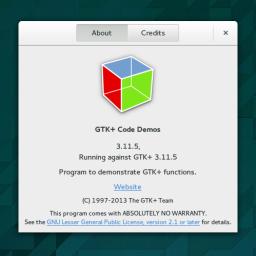The Future of GTK+
 Once hailed as the most free and widest used X toolkit, the future of GTK+ now looks dire. The gnome developers have essentially highjacked the latest version, GTK3, and are actively destroying all ability of non-gnome users from using this once popular toolkit. I find this very unsettling, as I have developed a number of my own desktop applications using GTK+ through all three of its major versions. I've always preferred GTK over QT, but with some of the recent changes, I'm starting to change my mind.
Once hailed as the most free and widest used X toolkit, the future of GTK+ now looks dire. The gnome developers have essentially highjacked the latest version, GTK3, and are actively destroying all ability of non-gnome users from using this once popular toolkit. I find this very unsettling, as I have developed a number of my own desktop applications using GTK+ through all three of its major versions. I've always preferred GTK over QT, but with some of the recent changes, I'm starting to change my mind.Of course, I'm hardly alone in this opinion as many other projects have abandoned GTK in the recent months. Take Audacious, for example. This GTK music player has had increasing troubles with the gnome developers screwing things up. So many troubles that they are now planning on switching toolkits rather than further deal with the upstream management. Although they had a functional GTK3 port, they've officially reverted back to GTK2 until they can properly refactor their entire program into QT.
I've been a happy user of the XFCE desktop environment for the last few years. This light and easy to use UI gets out of the way and just plain works. However, the interface toolkit of XFCE is tied to GTK2 and its authors have no clear upgrade path. A similar project, LXDE, has also seen the writing on the wall and are well into a rewrite project that switches their preferred toolkit from GTK to QT.
Although the "G" in GTK stands for "GIMP" this popular image manipulation program has yet to release a GTK3 version. Even Linus Torvalds' own pet project, Subsurface, has recently abandoned GTK for QT. Is the future of GTK+ programs doomed? Can a revival project, such as Mate, takeover maintenance of the GTK toolkit for the rest of us? (let the gnome people screw up their own fork)
Take the basic task of automounting for example. On my Gnome-based system (XFCE, which somehow makes use of GNOME daemons), it never works right. Sometimes it doesn't mount at all, sometimes it immediately mounts something I just unmounted etc. Come on man, it's 2014 and we're still dealing with this?
Since this stuff doesn't work so well, it changes constantly and you have to chase the GNOME/KDE guys just to make your application compile.
Tying your application to a desktop environment is a sure way to kill it. Now they're complaining about the GNOME stupidity, who knows KDE won't do the same thing? Money-backed big projects tend to attract tons of hippies and they really know how to mess up a good system. See firefox, gnome, systemd, chrome, etc.
GUI toolkits are a done deal. There is nothing left to be discovered with the current hardware. You can port them to newer features of graphics cards or X11 extensions but that's about it. The endless tail chasing Gtk+ and Qt does is nothing more than make-work. Come to think of it, if I just want to display some dialog and get some input, what drastical change has occured since the year 2000? Why can't we just use something done at that time for these basic tasks? Where is the need for updating the button-drawing code for the n-th million time?
I'd definitely go for a desktopless toolkit. There is nobody to mess it up and my program is likely to compile for a long time. There are tons of these: fox, fltk, wxwidgets, even java swing is a better choice than gnome+gtk. If you want advanced features like video playback or HTML display, it's a different matter but for an application which only needs standard controls? I'd never touch GTK or Qt.